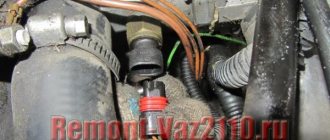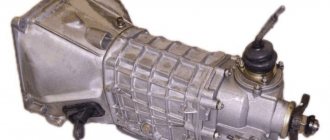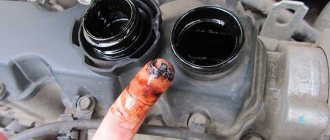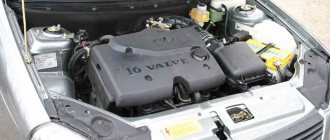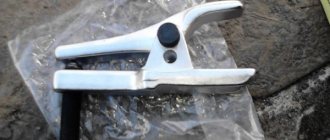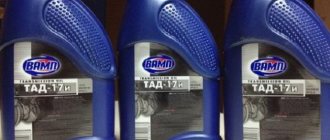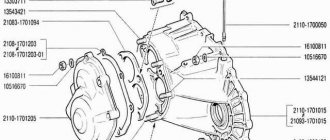How often do you change the oil in the transfer case? – According to the service book, replacement must be done every 40 thousand km. If the car is new, then the first replacement is carried out after 2 thousand km, and the subsequent ones after 40 thousand km. In addition, checking the oil level in the transfer case should be done every 10 thousand km, as well as if oil leaks are detected.
How much oil should be poured into the transfer case? – 0.79 l.
What kind of oil should I put in the transfer case? – Gear oil of API GL-5 quality and viscosity 75W-90. Recommended brands of oils and their full characteristics are indicated on the page Used fluids and filling volumes
How to check the oil level in the transfer case? – The transfer case must be cold. Clean the filler hole of the transfer case from dirt and unscrew the plug with a hex key.
The oil level should reach the bottom edge of the hole; check this with your finger. If the level is significantly lower, oil should be added until it begins to flow out of the hole. The procedure is performed using a syringe (shown below). Wait for the excess to drain before replacing the cap.
Replacement
We carry out the work on an inspection ditch or a lift. Before changing the oil, it is necessary to warm up the transmission by driving the car for at least 10 km.
Use a 12mm hex wrench to unscrew the drain plug...
. and drain the oil. (prepare a container of at least 1 liter for draining.)
After cleaning the magnet, screw in the drain plug.
Use a 12mm hex wrench to unscrew the filler plug...
...and fill the oil with a syringe.
Check the oil level - it should reach the lower edge of the filler hole.
We clean the breather located on the side of the rear propeller shaft from dirt (shown on the removed transfer case).
Video
The oil change in the transfer case on the VAZ 2121 and Niva 2131, as well as in all transmission elements, that is, the rear and front axles, is carried out according to the technical inspection card or every 35 thousand km. The transfer case uses the same brand of oil as the entire system. Before carrying out repair work, the car must be driven for 5-10 km so that the oil becomes liquid and the glass flows out of the system better.
Works
Then do the following sequence of actions:
Prepare an empty container, then use a nineteen hex key to unscrew the drain plug of the transfer case housing and drain the oil. Be careful when working as the oil is hot. The drain plug has a magnet to collect metal shavings and other debris, clean it, then screw the plug back into place.
Now, using a twelve-point hex wrench, unscrew the transfer case filler plug and use a technical syringe to fill it with new transmission oil.
Oil must be added to a level where it matches the lower edge of the filler neck.
Then tighten the plug. And at the final step, you need to clean the breather, which is located on the side of the rear propeller shaft.
The service life and quality of operation of the engine and gearbox directly depend on the correct choice of lubricants. All rubbing and rotating parts must be covered with a layer of oil, regardless of the temperature and intensity of the engine.
NIVA SUVs experience increased loads: “ragged” operation of the engine and gearbox, difficult temperature conditions. The lubricant is supplied to the lubrication units through special channels. If you select its characteristics incorrectly, you may encounter the following problems:
- The thickened technical fluid does not reach the friction unit.
- Due to high temperatures, the lubricant breaks down into fractions and loses its properties.
- Insufficient detergent properties do a poor job of cleaning.
- Poor-quality base or additives themselves become a source of deposits that clog the oil channels.
All this leads to increased wear of engine and gearbox components, and sometimes to crankshaft jamming.
Volume of oils and liquids Chevrolet Niva | Car breakdowns
Thus, when buying the same type of compound for drive axles, you will need at least 3 liters. The main aspect in the question of which gear oil is best for the Chevrolet Niva is not the manufacturer, but the prevention of mixing different compounds.
It is also not allowed to add fluids from those applicable for hydraulic power steering: The operation of all named parts of the box does not imply the use of filter parts during operation of the units. The process of updating transmission oil on a Niva Chevrolet jeep is not complicated, but unfortunately it requires careful work. You will need an inspection hole or installation of the car on the car Filler and drain plug of the Chevrolet Niva gearbox Prepare in advance consumables, an empty container for waste fluids and a rag to remove smudges.
To service the transfer case, you will also need a hex wrench for unscrewing the drain plug and a syringe for refilling Chevrolet Niva units and devices with the amount of oil in the axles.
Changing the oil in the Niva gearbox, transfer case and axles
It is better to carry out operations after the trip, given that the compositions have better fluidity. For the transfer case, work is carried out in the following order: When refueling, visually control the level of filling water, which should reach the lower edge of the filling window. Changing the oil in a VAZ box How to connect a rear view camera to a car radio with your own hands We have remained in the past, when a car was considered only a means of transportation.
Further, everything is according to the instructions: A large amount of dirt and shavings is a sign that the procedure should be carried out more often. Thoroughly clean all the holes in the axle oil reservoir; this can be done with a regular rag. Pour in fluids and let the car run; if the oil is gone, you can add the required amount.
The procedure is simple and even a beginner can cope with it, but if you have concerns or just want to get dirty, you can contact the nearest car service center.
This must be done regularly and not forgotten; each fluid change must be recorded and the current mileage noted. If you strictly follow the manufacturer's recommendations, there will be no problems with the SUV.
Tank characteristics The fuel tank of this model has almost sixty liters, or more precisely, the tank is located directly under the rear seat. In the upper part there is a small hatch under which the fuel pump is installed. The sensor will help determine the level of fuel fluid and the amount of gasoline. There are other Chevrolet Niva filling tanks, many of which are included in various systems.
Niva Chevrolet amount of oil in cooling bridges. The cooling system here is liquid, closed type.
This includes a radiator, pump, sensor. The capacity is 8 liters. Then the car is driven onto a viewing hole, overpass or lift. The waste is poured into prepared containers. Its condition is assessed for the presence of dirt and metal particles. New lubricant is added.
How much oil is in the rear axle of a Chevrolet Niva
Possible leaks are checked. You also need to clean the breathers of both bridges. The filler holes are inspection holes for checking the lubricant level. The liquid should be level with these holes.
If the vehicle was purchased with mileage, then it is necessary to check the oil level. Also, Chevrolet Niva, the amount of oil in the axles is not superfluous to replace all the oils. Chevrolet Niva filling volumes The first question before changing the oil in the Niva transmission is how much oil should be poured?
The answer to this question will be a table of car refueling volumes
Here you should pay attention to the volume of oil in the gearbox housing, in the transfer case and in the rear and front axle housings. In total you will need 4.84 liters, so you can safely take a 5 liter canister of oil
What kind of oil should I put in the Niva?
The most common engine installed on the VAZ 2121 - 8 valves, 83 l/s, volume 1.7 liters
. With such a volume, the engine is more torquey than revvy. In this case, the temperature regime is very important - you should choose which oil to pour into the NIVA engine based on weather conditions. The parameters recommended by the manufacturer are only suitable for an engine that has not passed the warranty mileage. There is a table generated based on the manufacturer's requirements.
Filling with a different lubricant is more expensive for yourself, since you may lose the warranty. Most NIVA owners change the oil themselves after the warranty period, saving money on maintenance. To extend engine life, it is important to choose the correct lubricant viscosity. This parameter directly depends on the weather. The general principle is that the higher the temperature, the higher the viscosity.
The engine is cooled not only by antifreeze, but also by oil. Too thin a lubricant heats up quickly, and heat transfer deteriorates. In addition, it is possible to leak through gaskets and seals. A heated liquid with a low coefficient will not hold the so-called well. grease stain.
The other side of the coin is if you fill it with thick oil in winter. Firstly, turning the crankshaft in solid oil is quite difficult even for a fresh battery. Secondly, the viscous lubricant will not pass through the channels, and the level of irrigation of the rubbing parts will be insufficient.
Changing the oil in the transfer case of a Chevrolet Niva
As for this car model, the oil needs to be changed every 50-80 thousand kilometers . As soon as the car has traveled more than 120 thousand kilometers, the oil should be changed every 45 thousand kilometers. For information! The vehicle operating instructions contain information on the frequency of oil changes, which every car owner must follow. But it would be better if the oil change procedure is carried out a little more often. This is due to the fact that car oil accumulates dust and dirt, which over time leads to contamination of vehicle traffic mechanisms. This is why many car owners advise changing oils more often than indicated in the instructions. To ensure that the oil can be drained without problems, you should start replacing it after the trip. On the way, the oil has time to heat up, thereby taking on a more liquid consistency. Changing the oil in the transfer case is not as difficult as it seems at first glance. To replace it, you need to drive the vehicle into an inspection hole, or raise the car on a lift. You will need a container designed to drain the oil, as well as a rag to remove all smudges. Do not forget about the hex wrench (size 12), and you also need to have a refill syringe .
Draining and filling oil into the Chevrolet Niva transfer case
1. First of all, unscrew the drain plug. Then the oil is poured into the prepared container. 2. The old oil is checked for metal shavings. It is also worth paying attention to the built-in magnet - inspect it. 3. Impurities and dirt on the stopper should be cleaned. Afterwards the plug should be screwed back on. 4. The filler hole has a screw-on plug; it must be unscrewed. 5. Transmission oil is poured through a filling syringe. The ventilation valve is inspected and cleaned . 7. It is necessary to remember or note in a notepad the mileage that was on the car at the time of the oil change.
Which oil is better, mineral or synthetic?
We will leave environmental issues to Greenpeace; for NIVA owners, the main thing is reliability. The point is in the base from which the technical fluid is made. Mineral water or semi-synthetic is cheaper to produce, but the resistance to delamination is much lower. On the other hand, replacing transmission fluid on NIVA SUVs occurs quite often; even the most unstable base simply does not have time to lose its factory properties.
The waste consumption of synthetics is higher, since the penetrating ability of such a base is better.
What kind of oil should I put in the NIVA box?
Since gearbox lubricants are not so expensive, you don’t have to skimp on quality. If you pour frankly cheap fluid of dubious origin, the gear will not engage at the right time. And repairing the box will cost more than the money saved. Just like for an engine, there are temperature tolerances for viscosity.
Parameters in the table.
The box is more sensitive to the quality of fluids, since it operates under increased loads in off-road modes. Despite the fact that when you buy a NIVA, mineral water is poured into the transmission, at the first replacement it is recommended to flush the gearbox and fill it with synthetic
.
This does not contradict the warranty, but the box will last longer.
What kind of oil should I pour into the Chevrolet Niva transmission?
The choice of oil for the transmission of a Chevrolet Niva car is carried out on the principle of inadmissibility of mixing oils whose compositions are different. Regarding the viscosity characteristics of oils, it is better to give preference to the use of the following oils:
- 75w-90;
- 80w-85;
- 80w-90.
Oils intended for distribution in SUVs are designated by the API GL-4 index. To replace, you will need a small amount of oil: approximately 0.8 liters. When you first fill the Niva transfer case with oil, you should remember how much oil is used. This will allow subsequent oil changes to be carried out without difficulty.
Based on the experience of auto repairmen and car enthusiasts, good transmission oil for Chevrolet Niva is produced by the following manufacturers:
- Gazpromneft: G-Box GL-4/GL-5 75W-90, G-Box GL-5 75W-90;
- Lukoil: TM-4 75w-90, TM-5 75w-90;
- Shell: Spirax S4 G 75W-90 (Getriebeoil EP), Spirax S5 ATE 75W-90 (Transaxle Oil), Spirax S6 AXME (Spirax ASX);
- Castrol: Syntrax Universal Plus 75W-90, Syntrans Transaxle 75W-90, Syntrans Multivehicle 75W-90;
- TNK: Trans KP Super 75W-90, Trans Gipo >Chevrolet Niva gearbox oil change
Power unit
The engine installed on the modern model of the Niva 21213 (214) car was inherited from its Soviet progenitor - the VAZ 2121, and in terms of fluid volumes they are almost identical:
- Liquid cooling system. Filled with antifreeze in an amount of 10.7 liters with a freezing point not higher than -40 ° C. The capacity of the interior heating radiator is also included in this volume.
- Crankcase. Motor oils are poured here, the brand of which depends on the operating conditions. Capacity: 3.75 liters, including oil filter filling.
The viscosity of the oil poured into the Niva engine must correspond to the outdoor temperature at which the car is operated. Possible modes and suitable oil brands are shown in the table:
When flushing the power unit during the process of replacing liquid lubricant, the same amount of flushing oil (3.75 l) is used, taking into account the size of the filter. Replacement is carried out after 8-12 thousand kilometers, depending on the quality of the oil. Flushing is usually performed after 3 engine lubricant changes. During operation, it is important to monitor the oil level in the engine crankcase using a special dipstick. If the level drops below the Min mark, it is urgent to add lubricant to the engine of the same viscosity as was previously filled.
Antifreeze needs to be updated at least once every 3 years or according to the degree of wear of the fluid. It is not recommended to dilute antifreeze with distilled water, either in winter or summer. In winter, the diluted liquid may freeze, and during the summer heat it may boil ahead of time, which will lead to overheating of the engine.
How to change the lubricant in the transfer case
Under normal conditions, changing the oil in the Chevrolet Niva transfer case should be carried out at least once every 60 thousand km. In difficult conditions, this procedure can be carried out more often. After the mileage of 120 thousand km is exceeded, it will be necessary to start changing consumables more often. This will need to be done every 45 thousand kilometers.
When deciding on the frequency of lubricant replacement, it is worth considering many factors, including the conditions of use of the vehicle. If the car often drives on country roads, then dust and dirt may accumulate in its components.
As a result, the transfer mechanism, as well as other vehicle components, may no longer function normally. In addition, moisture can penetrate into the lubricant from the environment. This may also not result in the best consequences. In addition to being protective, lubricating fluid also performs a cleaning function.
It is better to replace the “consumables” in the transfer case after the car has driven at least 5 km. It is important that the lubricant warms up. This way it will be more fluid.
To carry out the work you will need a lift or inspection hole. Immediately prepare a container to drain the old fluid and rags to remove smudges. You will also need a key for 12 and a syringe for refilling.
Transmission
The Niva 4x4 transmission system has the following filling volumes:
- transfer case - 0.79 l;
- gearbox - 1.6 l;
- rear axle - gearbox - 1.3 l;
- front axle - crankcase - 1.15 l;
- steering column - crankcase - 0.18-0.2 l.
As with the operation of a power unit, under different temperature conditions, transmission units and assemblies are filled with oils of different viscosities, which is reflected in the table:
As stated in the operating instructions, transmission lubricants need to be changed once every 30 thousand km. mileage At the same time, replacement is not provided for in the steering mechanism housing, only an addition through the top plug. The “native” oil for Zhiguli transmission units is considered to be TAD17I.
Transmission oils have good penetrating ability. Therefore, poorly clamped plugs and worn gaskets of units begin to gradually leak lubricant. In such situations, it is allowed to add oil of the same viscosity class and, preferably, the same manufacturer. If you do not top up during a leak, the lubricant level in the unit will decrease, which will lead to accelerated wear of expensive mechanisms.
Sequence of actions for changing the oil
Draining the old oil and filling in new oil in the front and rear axles of the Niva is a generally similar procedure, but differences still exist due to the design features of the domestic SUV. Changing the oil in the Niva's front axle is carried out simultaneously with, in any case, you will not need other tools and materials, including:
- a special technical syringe (or a funnel of suitable size and geometry);
- hex wrench 12;
- 17 mm spanner (working with a socket wrench will be extremely inconvenient and ineffective);
- rags, container for draining waste.
The drain hole can be found on the lower plane of the front axle, the filler hole is located on its side wall.
The procedure for changing the oil in the Niva's front gearbox:
To change the oil in the rear axle of a Niva, you will need the same tool, since both the drain and filler plugs are the same. However, the procedure itself is practically no different, with the exception of the location of the gearboxes:
As you can see, pouring new oil into both the front and rear axles of the Niva is a simple procedure. And, as already noted, it is carried out together with the replacement of lubricant in the gearbox and transfer case during TO-4, TO-8 and so on.
Periodically during operation, according to the technical inspection card, it is necessary to change the oil in the transfer case on a VAZ Niva 2121 and 2131. To carry out repair work, prepare a standard set of tools, after which drive the car onto an inspection hole, overpass or lifts. Also, before replacing, the oil in the transfer case must be warmed up; to do this, you should drive at least 10 km.
Other liquids and fuels and lubricants
Every car enthusiast should know by heart the maximum fuel capacity of his car. The fuel tank of the VAZ 21213 has a capacity of 42 liters, including reserve. The reserve refers to the amount of fuel remaining in the tank after the yellow warning light on the instrument panel turns on. The reserve amount is at least 5 liters. The car must be fueled with gasoline whose octane number is in the range of 91-93.
The car has a number of refueling tanks that the owner must monitor during operation:
- brake system with expansion tank, total capacity - 0.515 l;
- hydraulic clutch drive with expansion tank - 0.2 l;
- 2 plastic tanks with a volume of 2 liters each contain a supply of windshield and rear window washer fluid.
The clutch release drive and brake system are filled with hydraulic brake fluid (the most popular is DOT-4). It should be changed at least every 3 years, because the liquid has the ability to absorb water vapor contained in the air. As a result, all steel parts of the system in contact with it begin to corrode, which leads to complete or partial failure of the brakes.
If there is a leak in the clutch or brake system, the level in the expansion tanks decreases, so constant monitoring is required over them.
The level of brake fluid in the reservoirs must be maintained no lower than the corresponding mark on the plastic body of the container.
Liquid or clean water for washing glass is added if necessary; in winter, a non-freezing option is required. Otherwise, the ice will not only destroy the tubes, but also damage the electric pump.
Various thick lubricants are also used for maintenance and lubrication of the Niva:
- Litol - a composition for lubricating highly loaded bearing parts;
- CV joints-4 - lubricant for the hinges of the front axle shafts and door opening limiters;
- ShRB-4 is designed for processing ball joints and steering rods.
The list of refueling containers is useful for novice car enthusiasts who bought a used car with a lost instruction manual. The operation of such a car should begin with the replacement of all fluids and oils.
FILLING CAPACITIES
| Refillable system | Volume, l |
| Fuel tank (including reserve) | 42 (65*) |
| Engine cooling system (including interior heating system) | 10,7 |
| Engine lubrication system (including oil filter) | 3,75 |
| Gearbox housing | 1,6 |
| Rear axle housing | 1,3 |
| Steering gear housing | 0,18 |
| Transfer case housing | 0,79 |
| Front axle housing | 1,15 |
| Hydraulic clutch system | 0,2 |
| Hydraulic brake system | 0,535 |
| Windshield and headlight washer reservoir | 2,8 |
| Rear window washer reservoir | 2,0 |
| Power steering reservoir | 1,7 |
* For VAZ-2131 cars and its modifications.
Quantity, l
| Refueling or lubrication point | Name of materials | |
| Fuel tank | Motor gasoline with octane number 91–93, 95* | |
| Engine cooling system including interior heating system | Coolant with a freezing point no higher than –40°C | |
| Engine lubrication system, including oil filter, at ambient temperature: | Motor oils (with API quality level: SG, SH, SJ) | |
| from –20° to +45°С | ||
| from –25° to +35°С | ||
| from –25° to +45°С | ||
| from –30° to +35°С | ||
| from –30° to +45°С | ||
| Gearbox housing | Gear oils with quality level according to API GL-5 and viscosity 75W-90 | |
| Transfer case housing | ||
| Front axle housing | ||
| Rear axle housing | ||
| Steering gear housing | Gear oil 75W-90 | |
| Hydraulic clutch release system Hydraulic brake system | 0,2 0,515 | Brake fluid DOT-3, -4 |
| Windshield washer reservoir Tailgate washer reservoir | A mixture of water and windshield washer fluid | |
| Starter drive drive ring | ||
| Front wheel bearings | Litol-24 lubricant or imported analogues | |
| Cardan joint cross bearings | Lubricant Fiol-2U, No. 158 or imported analogues | |
| Front propeller shaft spline | Lubricant Fiol-1, CV joint-4 or imported analogues | |
| Door limiters | Grease Shrus-4 | |
| Seat moving slides | ||
| Tie rod joints and front suspension ball pins | ShRB-4 lubricant or imported analogues | |
| Battery leads and terminals, door keyholes | Automatic lubricant VTV-1 in aerosol packaging, CIATIM-201, -221, Litol-24 or imported analogues | |
| Door locks | Fiol-1 lubricant or imported analogues | |
| Rear brake pressure regulator | Lubricant DT-1 or imported analogues |
*For vehicles with fuel injection system equipped with an exhaust gas converter
Changing the oil in the Niva 21213, 2121 gearbox
According to the recommendations of the VAZ manufacturer, the oil level should be checked after every forty to sixty thousand kilometers, but practice shows that it is better to do this at least twice as often. If, during inspection, you find that the oil is dirty and smells of burning, this means that it needs to be changed immediately. This procedure is easy to carry out yourself. Changing the oil in Niva 21213 is done in exactly the same way as in 2121.
Changing the oil in the gearbox.
The entire operation must be carried out in the inspection hole, and before the operation you need to drive eight to ten km so that the oil warms up.
If you are changing the oil for the first time, the first thing you need to do is find the filler neck. It is located on the left side and may not be immediately noticeable due to the gimbal. Do not confuse it with the technological plug, which is located on the right.
Having found the neck, take a 12mm hex and unscrew the drain plug.
Place a container near the neck and let the oil drain.
Next, clean the plug magnet from dirt and metal particles and screw the plug back on.
Now take the 17 key and unscrew the filler plug.
Then, using a special syringe, fill the oil to the bottom edge of the hole and tighten the plug.
All.
By the way, sometimes it happens that the box becomes clogged with metal shavings or the seals begin to leak. In such cases, you just need to add oil.
| Refillable system | Volume, l |
| Fuel tank (including reserve) | 42 (65*) |
| Engine cooling system (including interior heating system) | 10,7 |
| Engine lubrication system (including oil filter) | 3,75 |
| Gearbox housing | 1,6 |
| Rear axle housing | 1,3 |
| Steering gear housing | 0,18 |
| Transfer case housing | 0,79 |
| Front axle housing | 1,15 |
| Hydraulic clutch system | 0,2 |
| Hydraulic brake system | 0,535 |
| Windshield and headlight washer reservoir | 2,8 |
| Rear window washer reservoir | 2,0 |
| Power steering reservoir | 1,7 |
* For VAZ-2131 cars and its modifications.
Refueling or lubrication point
Quantity, l
Name of materials
Motor gasoline with octane number 91–93, 95*
Engine cooling system including interior heating system
Coolant with a freezing point no higher than –40°C
Engine lubrication system, including oil filter, at ambient temperature:
Motor oils (with API quality level: SG, SH, SJ)
Gearbox housing
Gear oils with quality level according to API GL-5 and viscosity 75W-90
Transfer case housing
Front axle housing
Rear axle housing
Steering gear housing
Gear oil 75W-90
Hydraulic clutch release system Hydraulic brake system
Motor oils
| Oil brand | SAE viscosity grade | Group | Manufacturer | Regulatory document | |
| AAI | AP1 | ||||
| LUKOIL LUX | 5W-30, 5W-40 10W-40,15W-40 | B5/D3 | SJ/CF | STO 00044434-003 | |
| LUKOIL LUX | 0W-40, 5W-20, 5W-30, 5W-50, 10W-30 | B5/D3 | SL/CF | LLC "Lukoil-Permnefteorg-sintez", Perm | STO 00044434-003 |
| TNK SUPER | 5W-30, 5W-40 10W-40 | B5/D3 | SJ/SL/CF | TU 0253-008-44918199 | |
| TNK MAGNUM | 5W-30, 5W-40 10W-40,15W-40 | B5/D3 | SJ/SL/CF | TU 0253-025-44918199 | |
| ROSNEFT MAXIMUM | 5W-40, 10W-40 | B5/D3 | SL/CF | TU 0253-063-48120848 | |
| ROSNEFT OPTIMUM | 10W-30, 10W-40 15W-40 | B5/D3 | SJ/CF | OJSC "Novokuibyshevsk Oil and Additives Plant", Novokuibyshevsk | TU 0253-062-48120848 |
| ROSNEFT MAXIMUM | 5W-40, 10W-40 | B5/D3 | SL/CF | TU 0253-391-05742746 | |
| ROSNEFT OPTIMUM | 10W-30, 10W-40 15W-40 | B5/D3 | SJ/CF | OJSC "Angarsk Petrochemical Company", Angarsk | TU 0253-389-05742746 |
| ROSNEFT PREMIUM | 0W-40, 5W-40 5W-40 | B5/D3 | SJ/CF SL/CF SM/CF | OJSC "Angarsk Petrochemical Company", Angarsk | TU 0253-390-05742746 |
Continuation of the table. 2
| Oil brand | SAE viscosity grade | Group | Manufacturer | Regulatory document | |
| AAI | API | ||||
| EXTRA 1 EXTRA 5 EXTRA 7 | 5W-30 15W-40 20W-50 | B5/D3 | SJ/CF | OJSC "Omsk Oil Refinery", Omsk | TU 38.301-19-137 |
| EXTRA | 5W-30, 10W-40, 15W-40 | B5/D3 | SL/CF | OJSC "Omsk Oil Refinery", Omsk | TU 38.301-19-137 |
| ESSO ULTRA | 10W-40 | B5/D3 | SJ/SL/CF | Exxon-Mobil, Germany | |
| GTTURBO SM | 10W-40 | B5 | S.M. | Hanval INC, Korea | |
| LIQUI MOLY OPTIMAL | 10W-40 | B5/D3 | SL/CF | Liqui Moly GmbH, Germany | |
| MOBIL 1 MOBIL SYNT S MOBIL SUPER S | 0W-40, 5W-50 5W-40 10W-40 | B5/D3 | SJ/SL SM/CF SJ/SL/CF | Exxon-Mobil, Germany | |
| MOBIL 1 ESP FORMULA | 5W-30 | B6/D3 | SJ/SL SM/CF | ||
| RAVENOL HPS RAVENOL VSI RAVENOL LLO RAVENOL TSI RAVENOL Turbo-C HD-C | 5W-30 5W-40 10W-40 10W-40 15W-40 | B5/D3 | SL/CF SL/CF SL/CF SL/CF SJ/CF | Ravensberger Schmirstoffvertrieb GmbH, Germany | |
| SHELL HELIX: PLUS PLUS EXTRA ULTRA | 10W-40 5W-40 5W-40 | B5/D3 | SL/CF | SHELL EAST EUROPE Co, UK, Finland | |
| ZIC A PLUS | 5W-30, 10W-30, 10W-40 | B5 | SL | SK CORPORATION, Korea | |
Table 3
| Minimum engine cold start temperature, 0C | Viscosity grade according to SAE J 300 | Maximum ambient temperature, 0C |
| below -35 | 0W-30 | 25 |
| below -35 | 0W-40 | 30 |
| -30 | 5W-30 | 25 |
| -30 | 5W-40 | 35 |
| -25 | 10W-30 | 25 |
| -25 | 10W-40 | 35 |
| -20 | 15W-40 | 45 |
| -15 | 20W-40 | 45 |
Cooling liquids
| Liquid brand | Manufacturer | Regulatory document |
| Antifreeze-TS Felix | TU 2422-006-36732629 | |
| Cool Stream Standard | TU 2422-002-13331543 | |
| Cool Stream Premium | JSC "Technoform", Klimovsk, Moscow region. | TU 2422-001-13331543 |
| ANTIFREEZE SINTEC | CJSC "Obninskorgsintez", Obninsk | TU 2422-047-51140047 |
| LLC "TC Tosol-Sintez", Dzerzhinsk | TU 2422-068-36732629 | |
| ANTIFREEZE (antifreeze) LONGLIFE | CJSC "Dolfin Industry", Pushkino | TU 2422-163-04001396 |
Note: Service life and replacement of antifreeze in accordance with the vehicle service book. Mixing coolants of different brands is not allowed.
AIR CONDITIONING LIQUID
The air conditioner is filled with ozone-safe freon R 134 "A" Quantity - 0.4 kg
The air conditioning system uses ATMOSGU10 oil.
FLUID FOR SHOCK ABSORBERS
Liquid GRZh-12 Front shock absorber - 0.12 l Rear shock absorber - 0.195 l.
Glass washing and special fluids
| Liquid brand | Manufacturer | Regulatory document |
| GLASS WASHING LIQUIDS | ||
| LLC "ASD", Tolyatti | TU 2421-001-55894651 | |
| LLC "Multipharma-Samara", Samara | TU 2384-170-00151727 | |
| NPP "Makromer", Vladimir | TU 2451-007-10488057 | |
| CJSC "JSC ASPECT", Moscow | TU 2384-011-41974889 | |
| SPECIAL LIQUIDS | ||
| MOPZ VNII NP, Moscow | ||
| LUKOIL AJ | LLC "Lukoil VNP", Volgograd | TU 0253-025-00148599 |
| f. "VARYA", Nizhny Novgorod | TU 0253-048-05767924 | |
| Pentosin Hydraulic Fluid CHS 11S | f. Pentosin, Germany | TTM 1.97.0964 |
Greases
| Lubricant brand | Manufacturer | Regulatory document |
| Vaseline technical VTV-1 | TU 38.301-40-21 | |
| Vaseline technical ONMZ VTV-1 | TU 0255-195-05767887 | |
| Lubricant AZMOL GRAPHITOL | OJSC "Azmol", Berdyansk | TU U 23.2-00152365-178 |
| LIMOL lubricant | OJSC "Azmol", Berdyansk | TU 38.301-48-54 |
| LITA grease | OJSC "Azmol", Berdyansk | TU 38.101-1308 |
| LITOL-24 lubricant | OJSC "Azmol", Berdyansk | |
| Grease AZMOL LSC-15 | OJSC "Azmol", Berdyansk | TU U 23.2-00152365-180 |
| UNIROL-1 grease | JSC "Rikos", Rostov-on-Don | TU 38.301-40-23 |
| Grease UNIOL-2M/1 | OJSC "Azmol", Berdyansk | |
| Grease AZMOL FIOL-1 | OJSC "Azmol", Berdyansk | TU U 23.2-00152365-173 |
| Grease AZMOL ShRB-4 | OJSC "Azmol", Berdyansk | TU U 23.2-00152365-172 |
| Lubricant AZMOL SHRUS-4 | OJSC "Azmol", Berdyansk | TU U 23.2-00152365-182 |
| CV joint grease-4M | OJSC "Perm Plant of Lubricants and Coolants", Perm | TU 38.401-58-128 |
| Ortol Sh lubricant | JSC "Neftemaslozavod", Orenburg | TU 0254-001-05767887 |
| Grease CIATIM-201 | OJSC "Azmol", Berdyansk, OJSC "Rikos", Rostov-on-Don, LLC NPF "RUSMA", St. Petersburg, OJSC "Neftemaslozavod", Orenburg | |
| Grease CIATIM-221 | OJSC "Azmol", Berdyansk, OJSC "Rikos", Rostov-on-Don, LLC NPF "RUSMA", St. Petersburg |
Continuation of the table. 9
| Lubricant brand | Manufacturer | Regulatory document | |
| Solid lubricant Molybdol M3 | CJSC "Technology", St. Petersburg | ||
| Lubricating graphite “P” | OJSC "Azmol", Berdyansk | ||
| Ditor lubricant | JSC "Rikos", Rostov-on-Don | TU 0254-007-05766706 | |
| CASTROL S-058 grease | , Germany | ||
| MOLYKOTE X-106 grease | , USA | TTM 1.97.0115 | |
| Renolit JP 1619 grease | , Germany | TTM 1.97.0800 | |
| Lubricant Lucas PFG-111 | , Germany | TTM 1.97.0733 | |
Flushing fluids for the engine lubrication system
Table 10
Liquid brand Manufacturer Regulatory document AUTO WASHING OIL Lukoil-Nizhegorodnefteorgsintez, Kstovo, LLC Lukoil-Permnefteorgsintez, Perm STO 00044434-0122 WASHING OIL Novo-Ufa Oil Refinery OJSC, Ufa TU 0253-019-05766528 R OSNEFT EXPRESS OAO « Angarsk Petrochemical Company, Angarsk TU 0253-392-05742746 MP SYNTHETIC MP CLASSIC OJSC Omsk Oil Refinery, Omsk STO 84035624-005Note. Flushing fluids are used during maintenance in accordance with the service book when replacing the working engine oil with fresh one.
Fluid for refilling the hydraulic steering system
Table 12
List of products containing precious metals in LADA 4x4 cars
| Product number | product name | Location of precious metals | Weight in grams | ||
| gold | silver | palladium | |||
| 2115-3801010 | Instrument cluster | In semiconductors | 0,000263 | 0,016414 | |
| 2105-3747010-03 | Turn signal and hazard warning light switch | 0,0180561 | 0,0208012 | 0,103 | |
| 2105-3709310/-01 | Three lever switch | Coating | 0,1664 | ||
| 2101-3704010-11 | Ignition switch | In contacts | 0,14078 | ||
| 2105-3710010-03/-04 | Hazard switch | In contacts | 0,107 | ||
| 21213-3709607 | Heated rear window switch | In contacts | 0,11517 | ||
| 2113-3709609-10 | Rear fog lamp switch | In contacts | 0,115169 | ||
| 2104-3709612 | Rear window wiper and washer switch | In contacts | 0,403093 | ||
| 2107-3709608-01 | Heater switch | In contacts | 0,265997 | ||
| 21045-3709280 | Fuel heating switch | In contacts | 0,170288 | ||
| 2108-3720010-10/-11/-12 | Brake light switch | In contacts | 0,1681 | ||
| Generator voltage regulator | In semiconductors | 0,0534 | |||
| 2106-3828110 | Water temperature indicator sensor | In contacts | 0,0161637 | ||
| 2105-3747010-02/03 | Relay-breaker for direction indicators and hazard warning lights | Gold in semiconductors, silver in contacts | 0,00021 | 0,0731 | |
| 2105-3747210-12 | High beam relay | In contacts | 0,055 | ||
| 2105-37470-1010-12 | Low beam relay | In contacts | 0,055 | ||
| 2105-3747210-02 | Headlight wiper relay | In contacts | 0,137 | ||
| 2114-3747610 | Rear fog light relay | Gold in semiconductors, silver in contacts | 0,000998 | 0,034935 | |
The Niva 21214 car is distinguished by its increased cross-country ability on roads. The car has an engine that has a volume of 1.7 liters, which complies with Euro-4 standards. The transmission system includes a transfer case with a crankcase ventilation system. All components on the VAZ 21214, just like on the VAZ 21213, are characterized by a long service life. It is important to take proper care of the automotive system and select high-quality oil for the Niva.
The Niva SUV (VAZ 2121), which has all-wheel drive and is equipped with a manual transmission, is capable of producing 75 horsepower.
Selecting gearbox oil
Transmission fluid Lukoil GL4 75W-80
Which oil to choose? Transmission oils come in a wide range. You should pay attention to fuel that has the following viscosity: 75W-90, 85W-90. In particular, you can choose Lukoil 80W90 gear oil (GL5 class). When operating vehicles in winter, you should purchase 70W-90 oil, as it has a low viscosity. Semi-synthetic options are also suitable for refueling Niva 21213. It is better to carry out replacement at a specialized service center.
How much oil to fill? Approximately 0.8 liters of oil must be added to the Niva distributor. 1.6 liters of transmission fluid is poured into its high-speed box.
Before choosing a transmission fluid, you should always carefully study its composition.
Information on the types of oil required
Among the recommended oils for the Niva transfer case, the following products should be noted:
- TNK Trans Gipoid (80W-90). This is a multi-season transmission oil that is also suitable for transfer cases. The oil is made from high quality mineral base oils that have been deeply refined. In addition, such a base made it possible to achieve a high viscosity index. Eliminates premature wear of the transfer case and the presence of a modern package of functional additives.
- Gearlube LS (80W-90). This product is a mineral lubricating fluid, which, like the previous oil, can be used in transfer cases. This oil contains a base of first-class synthetic base oils, selectively refined oils, as well as a special extreme pressure additive system. Thanks to the presence of many additives, this oil is endowed with the highest oxidation resistance, high anti-corrosion resistance, optimal viscosity characteristics, as well as anti-foam properties, which not only increases replacement intervals, but also the service life of the unit.
- Lukoil TM-5 (75W90). Semi-synthetic lubricating fluid produced by a domestic manufacturer. This oil has excellent antioxidant and extreme pressure properties. It has optimal viscosity in almost any temperature conditions, which ensures quiet and smooth operation of the transfer case. This oil also differs from other products in that, compared to foreign oils, it has an affordable price.
- Agip ROTRA MP. This oil has a number of very useful properties. Among these, it is necessary to highlight the fact that, due to its composition, the oil is capable of creating a durable film on parts, which in turn ensures effective lubrication of rubbing elements. Among other properties, there is also high oxidation stability, due to which replacement intervals have been extended. The viscosity characteristics turned out to be quite excellent here, since the oil viscosity that is optimal for the operation of the transfer case is maintained at any temperature. A couple more key qualities of this oil should be highlighted, namely the presence of excellent anti-wear, anti-corrosion and anti-foam properties, which significantly increase the service life of the transfer case.
- Gazpromneft GL-5 (75W-90). This semi-synthetic lubricating fluid, like the previous oil, also has high extreme pressure, low-temperature and anti-corrosion properties, as well as resistance to mechanical destruction and resistance to thermal decomposition. The oil can significantly extend the operation of the transfer case, since in addition to all this it has very excellent viscosity characteristics.
- NOVOIL T (80W-90). It is a universal transmission oil, namely, it can be used in addition to gearboxes in transfer cases of imported and domestic passenger cars. Among the main properties of this oil, it is necessary to note resistance to low and high temperatures, oxidative processes, as well as extreme pressure properties.
The oil market now has many different products from a large number of manufacturers. For the VAZ-21213 car, in addition to everything previously mentioned, it is also recommended to use lubricants such as:
- UFALYUB UNITRANS (85W-90; GL-5).
- SAMOIL 4404" (85W-90; GL-5).
- NORSI (80W-90, 85W-90; GL-5).
- OMSCOIL SUPER T (85W-90; GL-5).
- SAMOIL 4405" (85W-90; GL-5).
- WELS TM (80W-90, 85W-90; GL-5).
- VELS TRANS (85W-90; GL-5).
- SAMOIL 4402" (85W-90; type GL-5).

